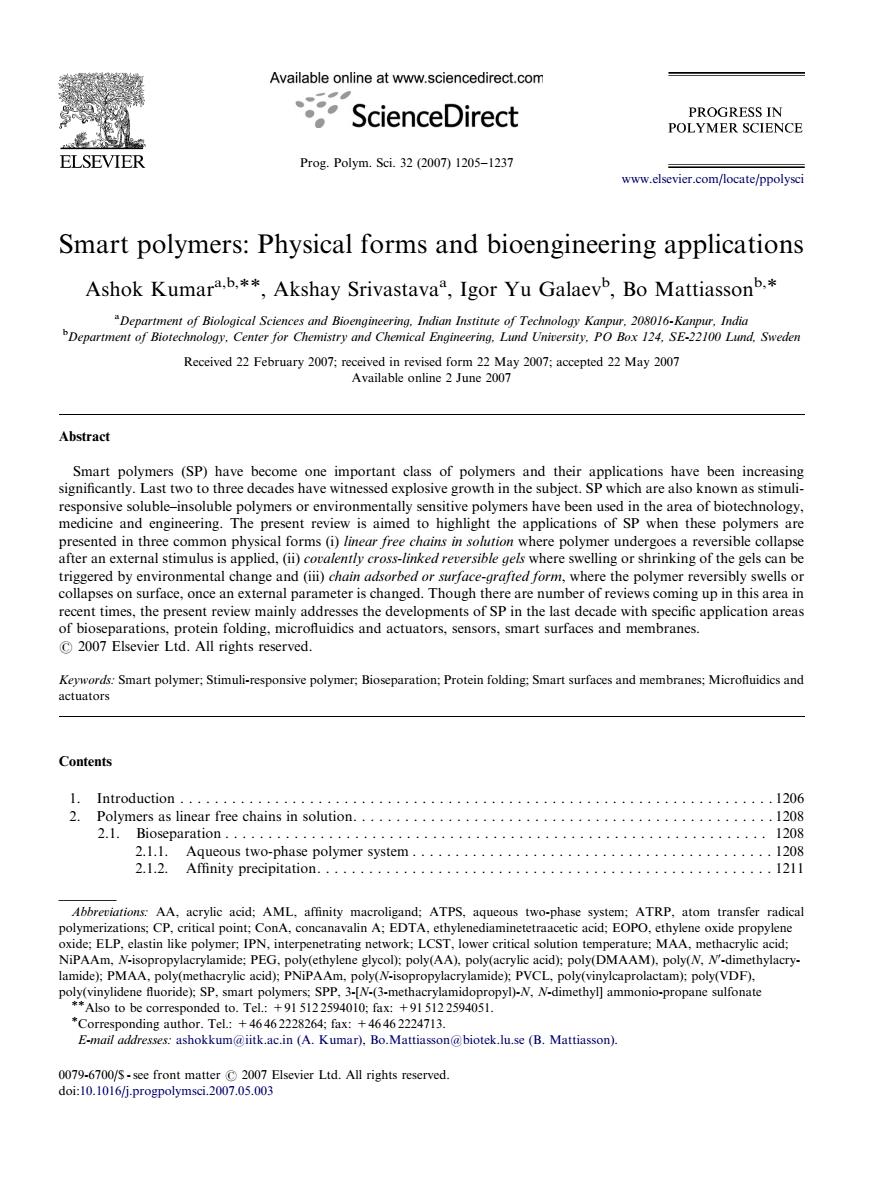正在加载图片...

Available online at www.sciencedirect.com ScienceDirect ELSEVIER Prog.Polm.ci.32(007120-1237 www.elsevicr.com/locate/ppoly Smart polymers:Physical forms and bioengineering applications Ashok Kumar,Akshay Srivastava",Igor Yu Galaev,Bo Mattiasson. Availa Abstract e o the abrer are also k medicine and enginering.The present review is aimed to highlight the applications of SP when these polymers ar ntal ch king of the geis collapses on surface.once an extemal parameter is changed.Though there are number of reviews coming up in this area in 2007 Elsevier Ltd.All rights re rved. Contents 1200 ers as linear free chains in solution. .1208 2.1.Bio separation 212 AieppCnohmerystem A kePR平iXPo 3Prog. Polym. Sci. 32 (2007) 1205–1237 Smart polymers: Physical forms and bioengineering applications Ashok Kumara,b,, Akshay Srivastavaa , Igor Yu Galaevb , Bo Mattiassonb, a Department of Biological Sciences and Bioengineering, Indian Institute of Technology Kanpur, 208016-Kanpur, India b Department of Biotechnology, Center for Chemistry and Chemical Engineering, Lund University, PO Box 124, SE-22100 Lund, Sweden Received 22 February 2007; received in revised form 22 May 2007; accepted 22 May 2007 Available online 2 June 2007 Abstract Smart polymers (SP) have become one important class of polymers and their applications have been increasing significantly. Last two to three decades have witnessed explosive growth in the subject. SP which are also known as stimuliresponsive soluble–insoluble polymers or environmentally sensitive polymers have been used in the area of biotechnology, medicine and engineering. The present review is aimed to highlight the applications of SP when these polymers are presented in three common physical forms (i) linear free chains in solution where polymer undergoes a reversible collapse after an external stimulus is applied, (ii) covalently cross-linked reversible gels where swelling or shrinking of the gels can be triggered by environmental change and (iii) chain adsorbed or surface-grafted form, where the polymer reversibly swells or collapses on surface, once an external parameter is changed. Though there are number of reviews coming up in this area in recent times, the present review mainly addresses the developments of SP in the last decade with specific application areas of bioseparations, protein folding, microfluidics and actuators, sensors, smart surfaces and membranes. r 2007 Elsevier Ltd. All rights reserved. Keywords: Smart polymer; Stimuli-responsive polymer; Bioseparation; Protein folding; Smart surfaces and membranes; Microfluidics and actuators Contents 1. Introduction . . . . . . . . . . . . . . . . . . . . . . . . . . . . . . . . . . . . . . . . . . . . . . . . . . . . . . . . . . . . . . . . . . . . . 1206 2. Polymers as linear free chains in solution. . . . . . . . . . . . . . . . . . . . . . . . . . . . . . . . . . . . . . . . . . . . . . . . . 1208 2.1. Bioseparation . . . . . . . . . . . . . . . . . . . . . . . . . . . . . . . . . . . . . . . . . . . . . . . . . . . . . . . . . . . . . . . 1208 2.1.1. Aqueous two-phase polymer system . . . . . . . . . . . . . . . . . . . . . . . . . . . . . . . . . . . . . . . . . . 1208 2.1.2. Affinity precipitation. . . . . . . . . . . . . . . . . . . . . . . . . . . . . . . . . . . . . . . . . . . . . . . . . . . . . 1211 ARTICLE IN PRESS www.elsevier.com/locate/ppolysci 0079-6700/$ - see front matter r 2007 Elsevier Ltd. All rights reserved. doi:10.1016/j.progpolymsci.2007.05.003 Abbreviations: AA, acrylic acid; AML, affinity macroligand; ATPS, aqueous two-phase system; ATRP, atom transfer radical polymerizations; CP, critical point; ConA, concanavalin A; EDTA, ethylenediaminetetraacetic acid; EOPO, ethylene oxide propylene oxide; ELP, elastin like polymer; IPN, interpenetrating network; LCST, lower critical solution temperature; MAA, methacrylic acid; NiPAAm, N-isopropylacrylamide; PEG, poly(ethylene glycol); poly(AA), poly(acrylic acid); poly(DMAAM), poly(N, N0 -dimethylacrylamide); PMAA, poly(methacrylic acid); PNiPAAm, poly(N-isopropylacrylamide); PVCL, poly(vinylcaprolactam); poly(VDF), poly(vinylidene fluoride); SP, smart polymers; SPP, 3-[N-(3-methacrylamidopropyl)-N, N-dimethyl] ammonio-propane sulfonate Also to be corresponded to. Tel.: +91 512 2594010; fax: +91 512 2594051. Corresponding author. Tel.: +46 46 2228264; fax: +46 46 2224713. E-mail addresses: ashokkum@iitk.ac.in (A. Kumar), Bo.Mattiasson@biotek.lu.se (B. Mattiasson).������